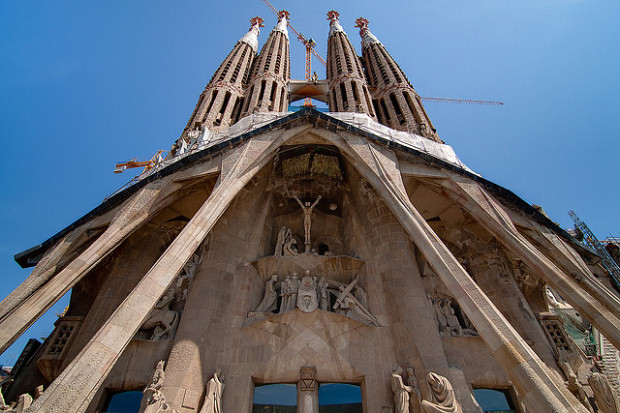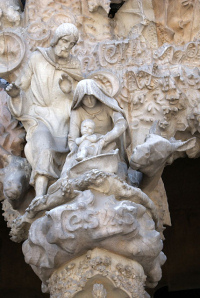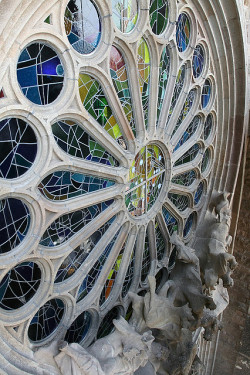La Sagrada Familia
Wednesday, November 3rd, 2010, 2:52 pm
La Sagrada Familia is Barcelona’s best known and most visited tourist attraction. Millions of people go to see Antoni Gaudi’s unfinished church every year.

The building of the church began on 19 March 1882. After 128 years it is still not finished.
La Sagrada Familia is a Roman Catholic Basilica, not a Cathedral. When it is completed, it will be the largest Basilica in the world. Barcelona’s cathedral is the Santa Eulàlia Cathedral.
The church has always been built from donations.
In 2005 it became part of UNESCO’s World Heritage Sites.
History:
The building of La Sagrada Família began on 19 March 1882. The first architect was called Francisco de Paula del Villar (1828-1901). At the end of 1883 Gaudí took over the project as chief architects. He did not abandon his position until his death in 1926. The architects who succeeded Gaudi have been following his original ideas.
Sagrada Familia is located in heart of Barcelona. Over the years the church became the city’s symbol and most visited tourist attraction. Millions of tourists visit it every year. In 2006 more than 2,3 million tickets have been sold.
Sagrada Familia has been built from donations from the beginnings. Now considerable amount are flowing in from ticket sales as well. The building of the church is expected to finish some time around 2030.
ORIGINS: 1866-1882
The idea of La Sagrada Familia came from Josep Maria Bocabella i Verdaguer, a wealthy book merchant, who led a religious association. His idea was to build a church where rich and poor could prey together.
In 1881 the association bought a plot of land. This is where Sagrada Familia stands now.
The building of the church began on 19 March 1882. The fist architect was Francisco de Paula del Villar y Lozano who designed a neo-Gothic church. He did not get along very well with the association and resign after a year.
His successor was Antoni Gaudi.
BEGINNINGS: 1883-1913
Gaudi took over the project in 1883 and initially followed the plans of the neo-goathic church. After the association received a large donation he proposed that they build a more grandiose church. His idea was approved. The plans of Gaudi’s dream church, the today’s Sagrada Familia was born.
The first façade Gaudi started working on was the Nativity façade. In 1911 Gaudi planned the Passion façade.
GAUDÍ: 1914-1926
After 1914, Gaudi worked solely on La Sagrada Familia. This is why he did not produce any other major works in the last years of this life. He became so involved that he moved to the building site.
The building progressed in a slow pace. On November 30 1925 the first bell tower of the Nativity Façade was completed. This was the only tower finished by the great master.
Half year later Gaudi was run over by a tram and died (10 June 1926). He was buried in one of the crypts of the church.
DEATH: 1927-1938
After Gaudi died Domènec Sugrañes became the head of the project. He was a close associate to Gaudi. He led the works until 1938.
In 1930 the other bell towers of the Nativity façade were finished. In 1933 the Faith door and the central cypress were completed.
In the days of the outbreak of the Spanish Civil War (1936), the church was attacked. In the raid original plans, drawings and photographs were lost; many of the scale plaster models were also demolished.
RESUMPTION: 1939-1985
After the civil war ended (1939) the construction continued. Francesc de Paula Quintana i Vidal, another long term associate of Guadi, was pointed chief architect. He restored the crypt and reconstructed a large number of the smashed models. The building was able to continue based on Gaudi’s original intentions.
In 1952 the Nativity staircase was completed. Also in this year the façade’s illumination was turned on for the first time in its history.
76 years after the first bricks were laid, the Holy Family sculptural group was placed on the Nativity façade on 19 March 1958. The sculptures were made by Jaume Busquets.

On 19 March 1958, to celebrate feast of St Joseph, the sculptural group representing the Holy Family, done by Jaume Busquets, was placed on the Nativity façade.
With its foundation, the building of the Passion façade was launched. This was based on studies Gaudi conducted between 1892 and 1917. The works continued with the crypt. This is where Sagrada Familia’s museum was set up in 1961. The museum tells the history of the church, and explains the symbolic and artistic aspects of Sagrada Familia. The four bell towers of the Passion façade were finished in 1977.
After 1978 the foundations of the nave and the crossing were finished. The columns, vaults, the main nave’s facades and the transepts were completed.
In 1986 Josep Maria Subirachs became chief sculptor for the Passion façade. His personal style is clearly visible on the façade.
PRESENT: 1986-2010
In 2000 the building of the Glory façade was started. The vaults of the central nave and the transept were completed. To celebrate the new millennium, a mass was conducted in the church.
The installation of the stained glasses in 2001 marked the completion of the Passion façade.

Based on Gaudi’s ideas the Glory façade choir was erected in 2006. Two years later (2008) the ambulatory of the apse was covered.
Between 2008 and 2010 the crossing and the apse are scheduled to be vaulted. Two more towers will also be finished in this period: (1) the tower of the central lantern and (2) the apse tower. The former will be crowned with a cross 170 m high. The latter will be dedicated to Virgin Mary.
Around the central tower will stand four more towers. These will be dedicated to the evangelists.
When the Glory façade is finished, La Sagrada Familia will be completed. Estimates put this around 2030.
Photo credits (in order of appearance): Powerkey, -12°C, Steph Matthews, SlapAyoda
About 8 years ago Luka
Tags: Barcelona, sagrada familia, spain
















